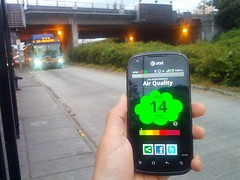
CitiSense screen (UC San Diego)
Computer scientists at University of California in San Diego created pollution sensors that monitor air quality in real time on smartphones. CitiSense, as the sensor system is called, comes from the lab of computer scientist William Griswold that described the system at the Wireless Health 2012 conference in October, also in San Diego.
The sensors in CitiSense detect ozone, nitrogen dioxide, and carbon monoxide, the most common pollutants emitted by cars and trucks. The smartphone app displays the sensor’s readings with a color-coded air quality scale based on the EPA’s air quality ratings, from green (good) to purple (hazardous).
One of the challenges faced by the team was ensuring a reliable return of high-quality readings with the device. Fellow computer science faculty member Sanjoy Dasgupta adapted a statistical technique called latent variable gaussian regression that uses adaptive or learning techniques to compute a lower boundary on readings.
This lower boundary, refined by the data continuously collected, makes it possible to remove noise from the valid signals and thus deliver high-quality readings in an uncontrolled environment. “Sensors will differ. Sensors will fail. People will breathe on them,” Griswold notes. “We wanted to make sure we got good data in these conditions.”
Prototype CitiSense devices were given for testing to 30 colleagues at UC San Diego, including those that commute some distance to the campus. Their tests of the device show pollution levels vary considerably among locations and time of day. One bicycle commuter, for example, found much higher readings indicating more pollution during the morning commute on a bike path parallel to a state highway, but very little going home on the same route.
As one might expect, higher pollution readings were recorded near streets and highways. That means however, explains Griswold, “The people who are doing the most to reduce emissions, by biking or taking the bus, were the people who experienced the highest levels of exposure to pollutants.”
The team discovered readings from the device helped their UC San Diego colleagues take action to limit their exposure to pollution. Bicyclists found they could reduce their exposure by moving their routes one block away from busy streets. Also, bus passengers avoided waiting near the vehicle’s tail pipe, where the air quality was poor. In addition, colleagues testing CitiSense shared what they learned, sometimes with total strangers who asked about the devices them when they were visible.
Some technical issues with CitiSense still need work. Data transfers from the sensors to the smartphones take a lot of the phones’ battery power, requiring the team to give the test subjects two chargers, one for home and one for the campus. The researchers found disabling the phone’s GPS when idle will extend battery life, as well as modularizing the software, so functions used less often are not routinely invoked, thus reducing the power drain.
The sensors currently cost about $1,000 per unit, but their price would likely come down once produced on a large scale. So far, the research team has built and deployed 20 devices in the field. Some of the sensors are on loan to colleagues at San Diego State University who are gauging air quality in San Ysidro, a community on the border between the United States and Mexico, and one of the most polluted areas in San Diego County.
Read more:
- Augmented Reality Applications Enhanced for Mobile Devices
- Challenge Seeks Smartphone GPS Jamming Detector
- Mobile Phones Enhanced to Transmit Emphasis, Emotions
- Smartphones Found Feasible Tools for Telemedicine Images
- Smartphone App Helps Monitor Lung Function
* * *

 RSS - Posts
RSS - Posts
[…] Portable Air Pollution Sensors Built Into Smartphones […]